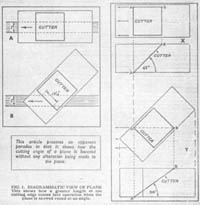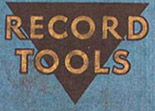Using Hand Planes – The Shearing Cut
 When you have to plane end grain or a specially hard wood you no doubt skew the plane at an angle so that it makes a shearing out. Why? Because you have found from experience that it eases the work. But have you considered just why this is? Well, in the first place skewing the plane round gives it more of a slicing cut. Think of when you carve the joint. You don’t just force the knife down; you draw it across the meat, and the more you do this the more easily it cuts. This is what happens on a reduced scale when you skew your plane at an angle. A greater width of blade is in operation for a shaving of the same width. For instance in Fig. 1 a piece of wood 1 in. wide is being planed, and when the plane is held square as at A it is clear that a 1 in. length of the cutter is doing the cutting. If, however the plane is held at an angle, say, 45 deg., shaving is still 1 in. wide, a length of nearly 1-1/2 in. of the cutter is in operation.
When you have to plane end grain or a specially hard wood you no doubt skew the plane at an angle so that it makes a shearing out. Why? Because you have found from experience that it eases the work. But have you considered just why this is? Well, in the first place skewing the plane round gives it more of a slicing cut. Think of when you carve the joint. You don’t just force the knife down; you draw it across the meat, and the more you do this the more easily it cuts. This is what happens on a reduced scale when you skew your plane at an angle. A greater width of blade is in operation for a shaving of the same width. For instance in Fig. 1 a piece of wood 1 in. wide is being planed, and when the plane is held square as at A it is clear that a 1 in. length of the cutter is doing the cutting. If, however the plane is held at an angle, say, 45 deg., shaving is still 1 in. wide, a length of nearly 1-1/2 in. of the cutter is in operation.
There is more in it than this, however. It virtually has the effect of lowering the cutting angle of the plane (the higher the angle the more the plane scrapes rather than cuts). This may sound a little foolish in that the plane itself has not been altered, but it is perfectly true. Take Fig. 2 at X. The cutter is set at 45 deg., and this is the effective cutting angle when the plane is held square as X. We can take any arbitrary point on the cutting edge, say A. The cutter rises at 45 deg. to the point B immediately behind it in line with the direction of the movement of the plane. Now turn to Y. The plane is skewed round at 45 deg. Taking the same point A on the cutting edge it is clear that the point B immediately behind it in line with the direction of the movement is now at the diagonally opposite corner. Since B remains at the same vertical height it is obvious that B is farther back and this means that the cutting angle works out at about 36 deg. Thus the more the plane is skewed round the lower the cutting angle becomes although the plane itself is not interfered with.
Originally from Woodworker Magazine (UK), 1947






